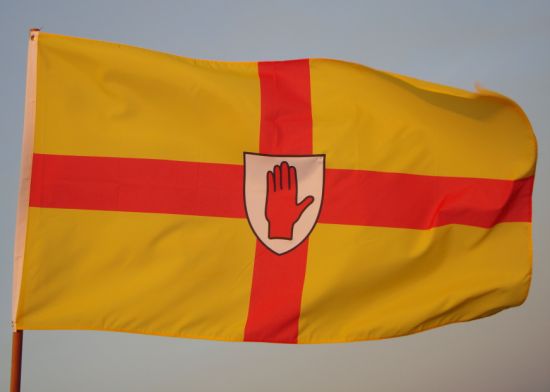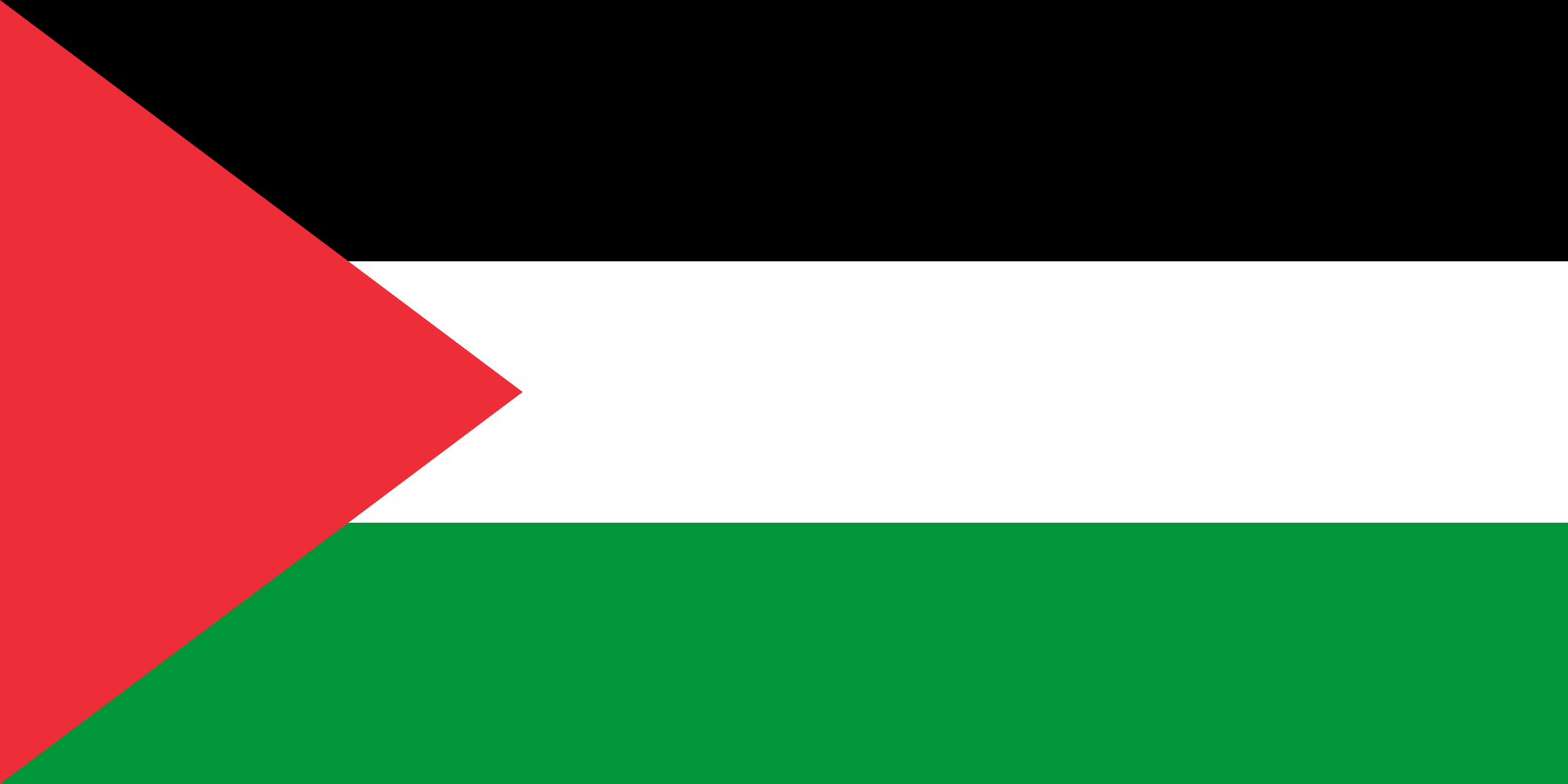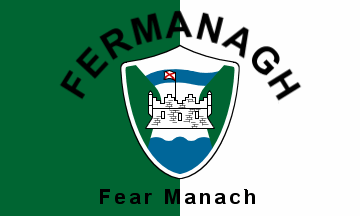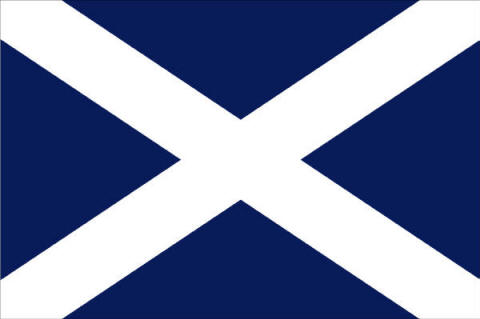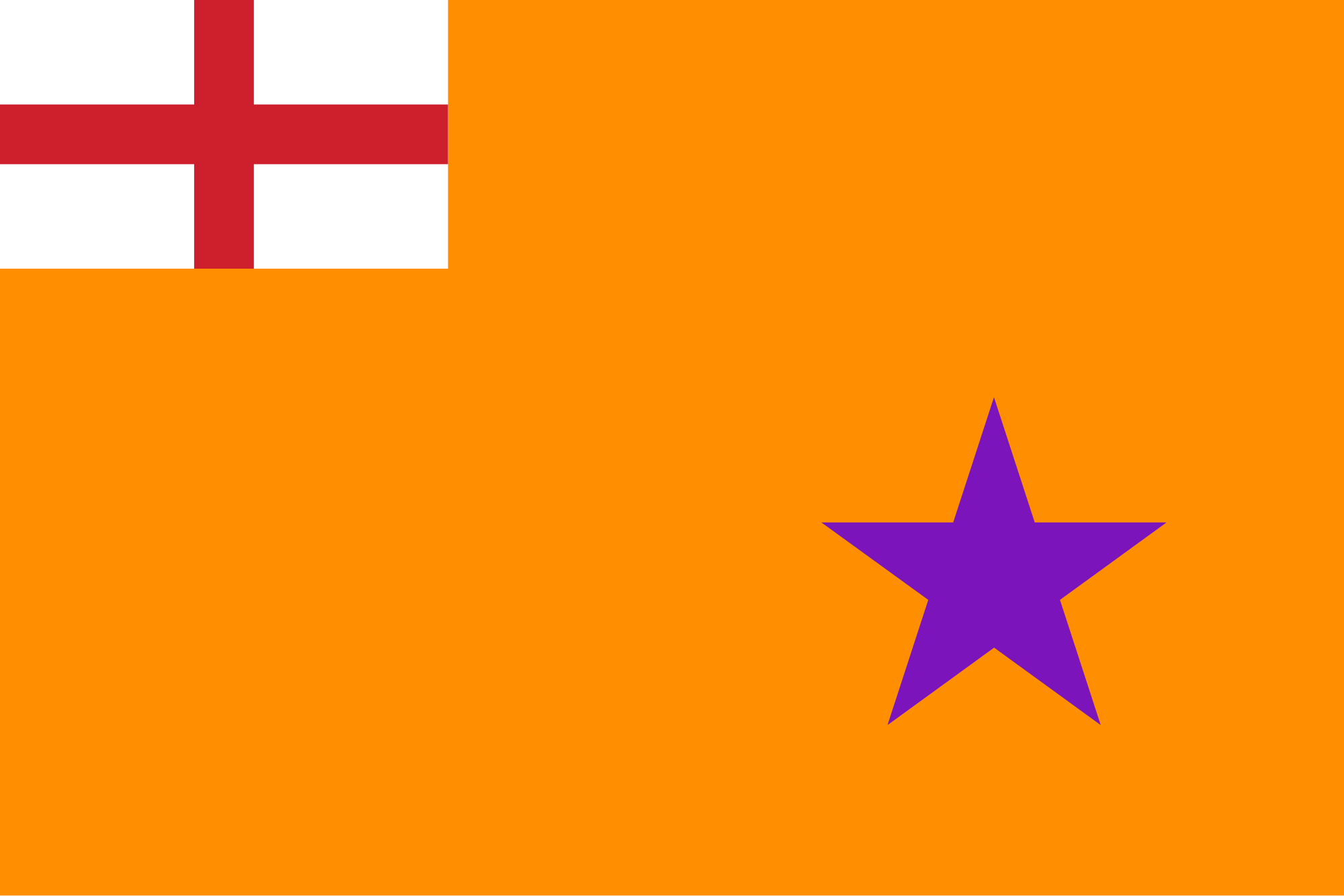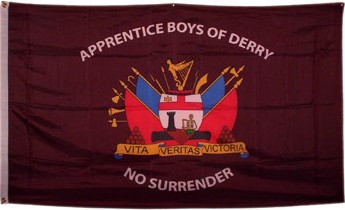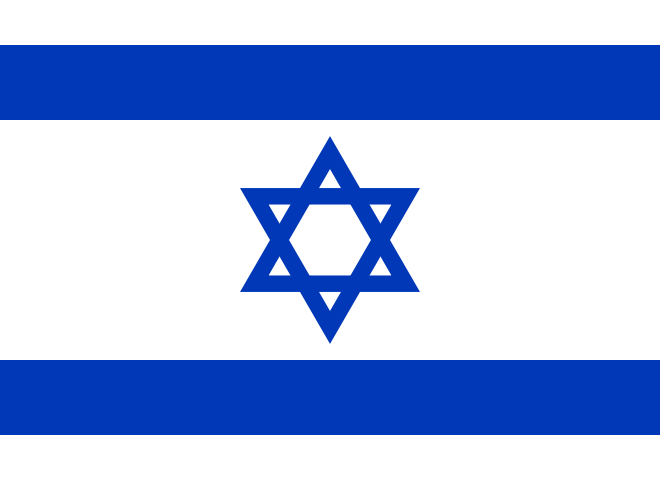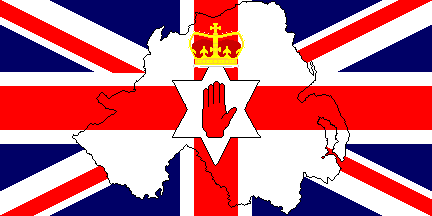Neutral Flags
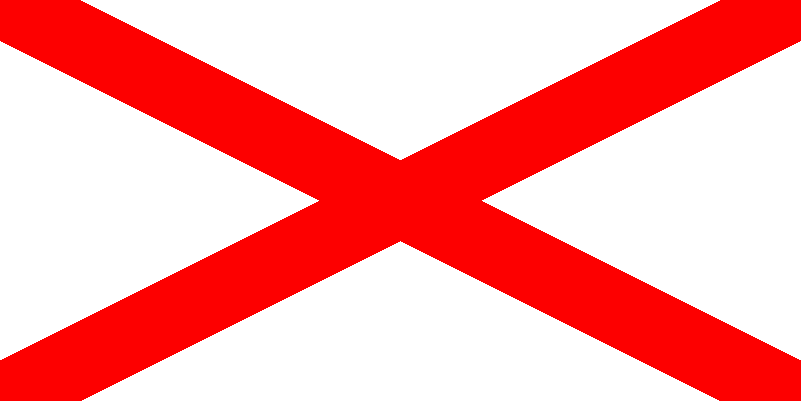
St Patrick's Saltire or St Patrick's Cross. Represents NI in UK flag. Often used as a cross community flag at St Patrick's Day celebrations. Used increasingly to represent NI, although technically an all Ireland flag. Also used in the Police Service of Northern Ireland Badge.
Irish Rugby Football Union (IRFU) Flag. Irish Rugby team represents the whole island and usually use this flag.
Although in recent matches I have noticed the Irish Republic flag alongside the Ulster Flag which isn't really politically or geographically correct.
Cricket Ireland Flag. Irish Cricket team also represent the island and used this flag.

Shamrock Flags. Various plain flags bearing shamrocks are often used by people as a neutral flag at sporting events or St Patrick's day. At the last Commonwealth games in India fans of Eamonn O'Kane a (catholic) N.Irish boxer represent Northern Ireland carried flags like this.
EU Flag. This is the flag of the European Union both the UK and
Eire are members. This is one of only three flags that has any leagl status in
the province and that can be used over central government and public buildings.
It often appears as a logo when various things are sponserd by the EU such as
the Peace III project.
City of Culture Flag. In 2013 Londonderry became the first ever UK city of
culture. This is supported by the whole community and the Derry-Londonderry
city of culture is hoping to help bring jobs, trade, tourism and the people of
Derry together in a place where division is still felt and can be seen. This
flag and flags like it can often be seen flown from buildings in the city
especially hotels.
 Police Service Flag. The only flag used by the Police Service of Northern Ireland, both as a colour and from flag poles on some police stations.
Police Service Flag. The only flag used by the Police Service of Northern Ireland, both as a colour and from flag poles on some police stations. Shannon-Erne Waterway flag. As the waterway is cross-boarder company vessels use this flag rather than any national flag.
Shannon-Erne Waterway flag. As the waterway is cross-boarder company vessels use this flag rather than any national flag.
Next I will do Nationalist and Republican flags only because there
are less of them:
Nationalist & Republican Flags
 Tricolour, National flag of the Republic of Ireland. Green White and Orange. Symbolises peace between Catholics and Protestants. But in Northern Ireland seen as Republican. The orange (which represents protestants) is often replaced with gold.
Tricolour, National flag of the Republic of Ireland. Green White and Orange. Symbolises peace between Catholics and Protestants. But in Northern Ireland seen as Republican. The orange (which represents protestants) is often replaced with gold.
Ulster flag. Flag of the Provence of Ulster. 6 of 9 counties make
up NI this is used to symbolise that Ulster is part of Eire. It's a combination of the ancient red hand and Hibernio-Norman burke coat of arms. The Burkes were the meadevil earls of Ulster. Historically the
arms of this flag appear on many unionist badges and symbols. But it has often
been used at Republican parades and rallies and the flag if not the arms are
seen as nationalist. It is however making a slight comeback to the unionist
community and is often seen alongside the Ulster Banner at Ulster Rugby
matches.
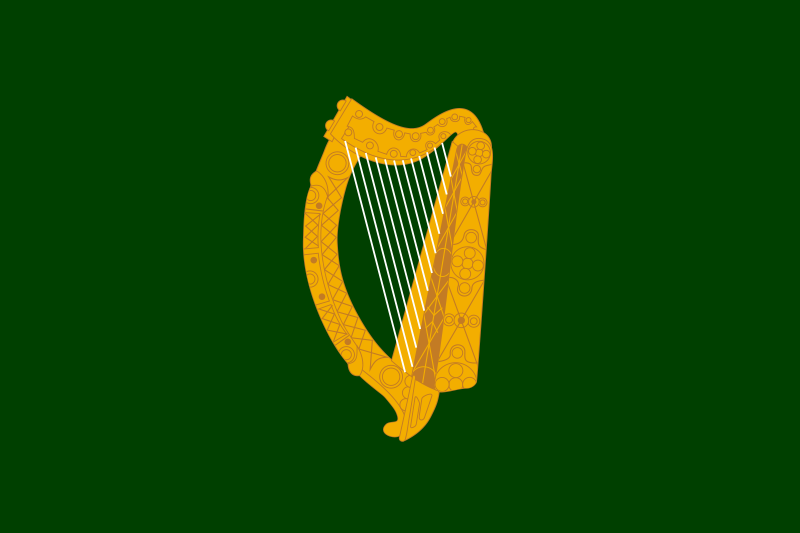
Province Flags
 Flags of the Provinces of Leinster, Connaght and Munster. These
are Used alongside the Ulster Flag to symbolise the want of an All-Ireland state
Flags of the Provinces of Leinster, Connaght and Munster. These
are Used alongside the Ulster Flag to symbolise the want of an All-Ireland state 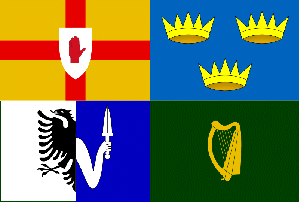
The may also be seen combined in a flag with each flag in one of the quarters. This is call the four provinces flag similar to the IRFU flag.

Sunburst Flag. flag represents the youth wing of the Irish Republican Army (IRA).
Fianna na hÉireann. The symbol of the sunburst can be seen on some Republican
murals, highlighting the dawn of a new era. Its use dates to militant republicanism in the 19th century.

The Starry Plough. Takes the Star formation of the big dipper in the shape of a plough. This flag comes in three forms
It was first used by the Irish Citizen Army who were a
socialist organisation which fought in the 1916 Easter Rising. Today associated
with the Irish National Liberation Army(INLA).
An alternative version which I think is based on the colour of
the Irish Citizen Army. Has also been used in other paramilitary colours.

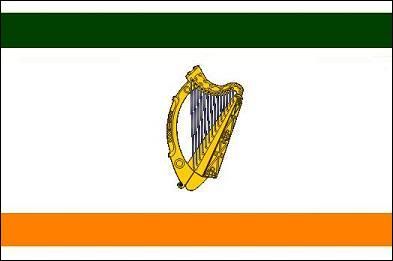 IRSP Flag. The Flag of the (slightly militant) Irish Republican Socialist Party uses the Starry Plough on a red field, red flags having links with socialism and the starry plough links with the socialist Irish Citizen Army of 1916.
IRSP Flag. The Flag of the (slightly militant) Irish Republican Socialist Party uses the Starry Plough on a red field, red flags having links with socialism and the starry plough links with the socialist Irish Citizen Army of 1916.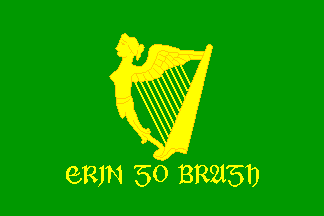
Harp Flag. Many Nationalist flags bear a harp, these vary from form to form and can be seen on plain green backgrounds or even defaced tricolours. The green flag here is based on the colour of the (US) 69th regiment with Erin go Bragh(Ireland for Ever).
The province of Leinster flag is green with a harp, as is the Republic of Ireland's Naval Jack. A Green flag with a harp was used by Irish Catholic Confederates, and the United Irishmen in the 17th and 18th Centuries. A green flag with a gold harp was used as an unofficial de facto national flag by nationalists throughout the 19th and early 20th Century. A blue flag with a gold harp is used as the presidential standard for the President of Ireland (Republic) which is a banner of the national coat of arms, and a harp on a blue background appears on the Royal Standard and coat of arms (UK) representing Northern Ireland.
Commemorative Flag. More Common in the Republic but not unheard of in NI. This flag commemerates the origional IRA who fought in the Anglo Irish Conflict and later formed the Republic's armed forces (Irish Defence Forces) it has no links to the modern Terrorist organisation of the same name. The badge is that of the Defence Forces.
IRA Flag. Flags of the IRA terrorist group are normally based on tricolours some even bear weapons or clenched fists. These can still be seen in the more extremist areas.
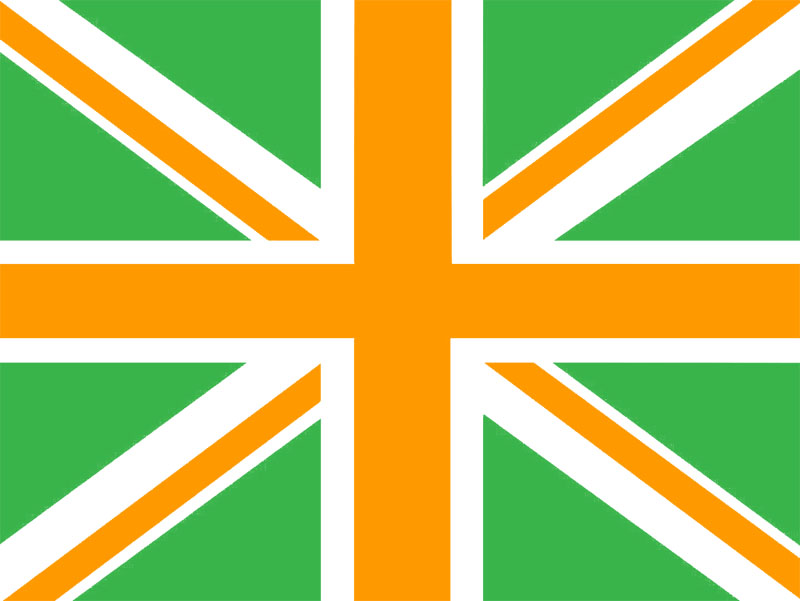
Irish Union Jack. A Union Jack in the colours of the Republic of Ireland. This is to show defiance to and insult the British.

Celtic Nations Flag. Representative of Ancient Irish Celts and friendships with the celtic and sometimes republican aspects of the countries represented on it (Brittany(France) Isle of Man, Scotland, Ireland, Cornwall(England) and Wales). Note Northern Ireland is not recognised as a separate country from the Republic of Ireland in this flag and is represented by the Republic's Tricolour.

Celtic (pronounced Sell-tick) Football club. Scottish Premier
League club in Glasgow (Catholic team) connections with Ireland(Republicans)
many Celtic flags also consist of tricolours defaced with the club badge.
Flag of Palestine. The Palestine/Israel situation is often
compared to Northern Ireland troubles. With many Nationalist sympathising with
the Palestinians. The IRA also had/has links with the PLO.
The flag of the Holy See is used as a symbol of Catholicism (generally speaking unionists are protestant and nationalists catholic)

GAA Flags. The Gaelic Athletics Association is very important in Nationalist and Irish culture and many communities fly the flag or flags of their team usually they fallow this pattern. They also may use checker flags in the team colours. For a list of the official county flags see here.
The 32 County Sovereignty Movement is a Republican political wing
that are opposed to the peace process. they are probably associated with terrorists and paramilitaries, their flags can often be seen in
more extremist areas they also come in green
Unionist
Last but by no means least is the flags of the Unionist and Loyalist
communities. Unionists enjoy their flags and often design and sell an awful
lot, not always vexollgically correct. these are only some of our flags:
 Union Flag/Jack National Flag of the UK. Is the only flag that has
any legal status in Northern Ireland. (with the exception of the EU flag and Royal Standard)Used by Unionists to show their
Britishness. This flag is made up of the cross of St George(England) St
Andrew(Scotland) and St Patrick(Ireland). Defaced forms of this flag with the
NI coat of arms or red hand are also popular.
Union Flag/Jack National Flag of the UK. Is the only flag that has
any legal status in Northern Ireland. (with the exception of the EU flag and Royal Standard)Used by Unionists to show their
Britishness. This flag is made up of the cross of St George(England) St
Andrew(Scotland) and St Patrick(Ireland). Defaced forms of this flag with the
NI coat of arms or red hand are also popular. Ulster Banner. Banner of the old NI government coat of arms. Official flag of Northern Ireland until 1973. Still
used by the Irish Football Association and Commonwealth games. Used by
Unionists. Often appears with a union flag in the Canton.
Ulster Banner. Banner of the old NI government coat of arms. Official flag of Northern Ireland until 1973. Still
used by the Irish Football Association and Commonwealth games. Used by
Unionists. Often appears with a union flag in the Canton.
St Andrew's Saltire or Cross of St Andrew. Flag of Scotland. Represents the
close links between Ulster and Scotland (which can often be seen from N.Irish
coast). Many Protestants use this flag to show their Scottish Ancestry
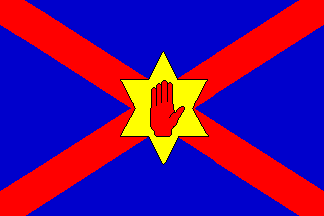
Flag of the Ulster Nationalist movement which wants an independent
Ulster Nation from both Dublin and London. Features a St Patrick's Saltire on
top of that of St Andrew. Despite being a Separatist flag it is often used by
unionists to represent Ulster-Scots and a secondary NI flag.
The Boyne Standard. This flag is said to have been carried before William III at the battle of the Boyne in 1690. Today it is often associated with and used by the Orange
Order. The Loyal Orders and marching bands traditions are very important to Ulster
Protestants.

Crimson Banner. This flag is the historic flag of Londonderry.
Today it is associated with the Apprentice Boy's of Derry (loyal order) Some versions appear with the city coat of arms and
Apprentice Boys of Derry and No Surrender.(the Battle Cry of the defenders at
the 1688-89 siege of Derry) Legend has it the original flag was a rag that
Colonel Mitchelburn(governor of the city) dipped in blood and flew in defiance
of the enemy in the siege of 1688-89.
 Ulster-Scots flags vary often from maker to maker but nearly always
consist of St Andrew's Saltire defaced with the red hand. Some designs have the
red hand with thistle leaves. Many Protestants (in particular Presbyterian's)
have Scottish backgrounds and have retained many aspects of their heritage and
culture despite living in N.Ireland for about 400 years
Ulster-Scots flags vary often from maker to maker but nearly always
consist of St Andrew's Saltire defaced with the red hand. Some designs have the
red hand with thistle leaves. Many Protestants (in particular Presbyterian's)
have Scottish backgrounds and have retained many aspects of their heritage and
culture despite living in N.Ireland for about 400 years
Many NI football fans carry flags that bear the IFA badge. These
vary but often carry slogans such as "Our Wee Country," We're Not
Brazil" Some even have the names of the 6 counties or a map.
The Ulster Volunteer Force(UVF) was raised in 1912/3 to resist
home rule. it later became integrated into the British Army in WWI. A terrorist
group was formed in the 1970s took and use this name UVF. Therefore these flags
are hard to police(terrorist flag are illegal) as it is often unclear if they
are historical or terrorist.
Young Citizens Volunteer (YCV) was a youth wing of the original
UVF and also became integrated into the army during WWI. As well as Young
Citizen Volunteers this flag bears WWI battle honours and the Army unit (14th
battalion Royal Irish Rifles)
Other Paramilitary flags seen in more extremist communities are
the Ulster Defence Association(UDA) and Ulster Freedom Fighters (UFF)
Israel Flags, Jews often integrate into the Protestant community and often use their
own versions of flags. Here the Ulster Banner is combined with the Israeli
flag. The Israel flag is used by unionists the same way Nationalists use the
Palestine flag.
 Despite Royal Flags being only for the use of Royalty. Loyalists
often use these flags as a show of loyalty. The Royal Arms of Scotland are
sometimes used to show loyalty to the monarch of Scotland.
Despite Royal Flags being only for the use of Royalty. Loyalists
often use these flags as a show of loyalty. The Royal Arms of Scotland are
sometimes used to show loyalty to the monarch of Scotland. Royal Irish Regiment. Despite the Army recruiting men and women both North and South as well as from both communities, many unionists support the troops where nationalists don't. The flag on the left is the camp flag of the Royal Irish Regiment(easily available in shops) where the one on the right is an unofficial flag that came out for regiments first home coming from Afghanistan. The Regiments Motto is Faugh-A-Ballagh (Clear the Way).
Royal Irish Regiment. Despite the Army recruiting men and women both North and South as well as from both communities, many unionists support the troops where nationalists don't. The flag on the left is the camp flag of the Royal Irish Regiment(easily available in shops) where the one on the right is an unofficial flag that came out for regiments first home coming from Afghanistan. The Regiments Motto is Faugh-A-Ballagh (Clear the Way).
Ulster Defence Regiment(UDR). The UDR (not to be confused with
UDA) was a local often part-time Army Unit that specialised in Anti-Terrorism
in the Troubles. It merged with the Royal Irish Rangers in 1992 to form Royal
Irish Regiment. The UDR was often portrayed as the "Defenders of
Ulster" from terrorism in the unionist community.
Glasgow Ranger Football Club. Rivals of Celtic the main
Protestant team in the Scotland close links with NI and particularly Linfield
football club in Belfast.
Many flags feature people past and present these vary from union jacks
defaces with the Queen's face to flags like this one with King William III
Prince of Orange.
Flag of the 36th(Ulster) Division. This was a UK army Division in
WW1 that was from Northern Ireland and has many proud battle honours. In
Loyalist identity the Boyne is the big battle but the Somme in WW1 is not far off
it, nearly every family in NI had a relative who died in WWI, and this also reflected in many flags.
Many Union Jacks are deface with symbols with a red hand. This one
has a old NI flag in the shape of a map of NI
Other Flags
 City of Belfast flag. a Banner of the city coat of arms. Although a registered flag it is not normally used.
City of Belfast flag. a Banner of the city coat of arms. Although a registered flag it is not normally used. Down District Council Flag, often distributed with St Patrick's Cross on St Patrick's Day in Downpatrick.
Down District Council Flag, often distributed with St Patrick's Cross on St Patrick's Day in Downpatrick.
Londonderry Flag, A crimson flag bearing the city coat of arms, occasionally used by Derry City Council over its administrative offices.
 Commissioners of Irish Lights UK Ensign. Used on Irish Lights vessels registered in Northern Ireland and/or Great Britain
Commissioners of Irish Lights UK Ensign. Used on Irish Lights vessels registered in Northern Ireland and/or Great Britain Royal National Lifeboat Institution house flag. Used on lifeboat stations throughout the British Isles,
Royal National Lifeboat Institution house flag. Used on lifeboat stations throughout the British Isles,  Royal National Lifeboat Institution ensign. Used on all sea going RNLI lifeboats in the United Kingdom.
Royal National Lifeboat Institution ensign. Used on all sea going RNLI lifeboats in the United Kingdom.Redundant Flags
Flags that were once officially used but are now redundant
 Civil Defence Flag. Civil Defence were civilians who did jobs such as air raid wardens and rescue workers during the blitz in WW2 and during the Cold War. During WW2 both Belfast and Londonderry were bombed by the German Air Force.
Civil Defence Flag. Civil Defence were civilians who did jobs such as air raid wardens and rescue workers during the blitz in WW2 and during the Cold War. During WW2 both Belfast and Londonderry were bombed by the German Air Force.  Commissioners of Irish Lights house flag in Northern Ireland used to be a cross of St George before the St Patrick's Saltire was adopted
Commissioners of Irish Lights house flag in Northern Ireland used to be a cross of St George before the St Patrick's Saltire was adopted British Airports Authority Flag. BAA originally ran both Belfast City and International Airports until they were sold to private companies
British Airports Authority Flag. BAA originally ran both Belfast City and International Airports until they were sold to private companies  Police Ensign. The Royal Ulster Constabulary(name of the police before it changed to Police Service of Northern Ireland) operated a number of boats in Lough Erne to counter illegal weapon smuggling. The vessels used by the police used a blue ensign with the police badge (then a harp and crown). The current police service no longer uses this badge or name and has no vessels currently in permanent service.
Police Ensign. The Royal Ulster Constabulary(name of the police before it changed to Police Service of Northern Ireland) operated a number of boats in Lough Erne to counter illegal weapon smuggling. The vessels used by the police used a blue ensign with the police badge (then a harp and crown). The current police service no longer uses this badge or name and has no vessels currently in permanent service. Governor of Northern Ireland Flag. Northern Ireland being on a separate island than mainland UK and having its own local parliament (unique in the UK at that time) once had a governor who represented the crown. The Flag is similar to other British Governor flags, a Union Flag, wreath and coat of arms. Like the Ulster banner this flag was made redundant when the Northern Ireland Parliament was abolished in 1973.
Governor of Northern Ireland Flag. Northern Ireland being on a separate island than mainland UK and having its own local parliament (unique in the UK at that time) once had a governor who represented the crown. The Flag is similar to other British Governor flags, a Union Flag, wreath and coat of arms. Like the Ulster banner this flag was made redundant when the Northern Ireland Parliament was abolished in 1973. Government ensign. This rather ugly flag was used on vessels commissioned by the Government of Northern Ireland (GNI) between 1929 and 1973.
Government ensign. This rather ugly flag was used on vessels commissioned by the Government of Northern Ireland (GNI) between 1929 and 1973.
Well a guide to the more common flags in Northern Ireland, this is
in no way political, cultural or religious but merely informative.



